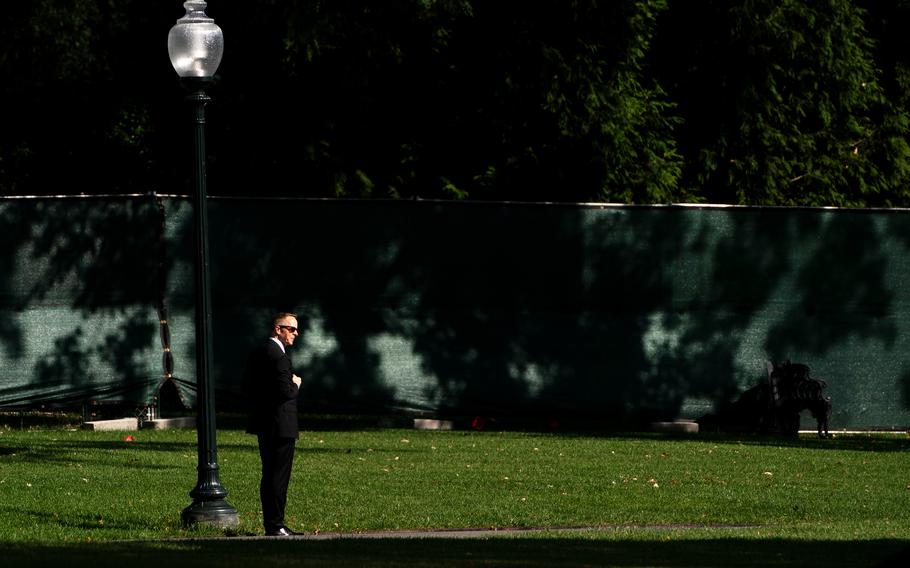
A Secret Service Agent watching during US President Joe Biden departure on the South Lawn at the White House in Washington on September 20, 2021. MUST CREDIT: Washington Post photo by Demetrius Freeman (Demetrius Freeman/The Washington Post)
With its elite mission to protect the president, the Secret Service would seem to be the pinnacle for law enforcement officers.
Instead, the job is “a grind” that makes many employees flee overloaded working conditions, according to a report requested by the agency’s leadership.
The morale of Uniformed Division (UD) officers, who guard the White House, is so bad that a new study by a National Academy of Public Administration (NAPA) panel said job satisfaction and employee engagement are at a “concerning level of risk” related to a “crisis in UD work-life balance.”
NAPA provides advice to government leaders as an independent, nonpartisan congressionally chartered organization. Its current tough assessment is particularly troubling because it comes after improvements following earlier budget cuts and a series of embarrassing incidents that slashed the agency’s stellar image.
The public sees single-minded, resolute, plain-clothed agents with earpieces and sunglasses talking into their sleeves standing within reach of the most powerful person in the world. Visitors to the White House and presidential events must pass by uniformed officers in crisp white shirts, checking credentials and inspecting bags. They all are dedicated, determined and not to be messed with.
But their working conditions mess with them.
Despite the prestige of working at the White House, “for the bulk of its Officers,” the report found, “the work, with long, repetitive hours, has become a grind. Many Officers encountered in this study face burnout.”
Although there has been progress over the years, the agency remains underfunded and understaffed, resulting in an exhausted workforce in pursuit of a “no-fail” mission.
“Mission demands continue to increase, while staffing levels have not risen at the same pace, requiring the workforce to work significant overtime,” NAPA said. “Longer hours mean more fatigue and an increased sense of monotony on the job, along with less time to train, and less time at home spent with family or pursuing outside interests.”
Some of that frustration might have been taken out on agency cars. Citing the “often deplorable state of vehicles,” including missing floorboards, NAPA said there are “cases of intentional damage” to patrol cruisers. “Officers feel that they do not possess the quality of equipment essential to effectively accomplish their job,” according to the report.
Increasingly intense threats against Secret Service protectees and the growing sophistication of the financial crimes the agency investigates coincided with previous budget cuts and hiring freezes. That might have contributed to the negative incidents that once damaged its reputation, as my colleague Carol Leonnig has reported and chronicled in a book this year. Among the most scandalous was the recall of agents involved with prostitutes while serving on former president Barack Obama’s detail during a 2012 summit in Colombia. Among the most dangerous was in 2014 when a man with a knife slipped through the White House front door and into the mansion before he was stopped. In 2015, the Secret Service ranked last among federal law enforcement agencies in the influential “Best Places to Work in the Federal Government,” published by the Partnership for Public Service.
Although the agency has emphasized programs to enhance the Uniformed Division, “attrition is especially problematic,” according to the Academy. Coupled with 30 percent of the uniformed officers having fewer than three years on the job, this leaves the Secret Service with “a large portion of their law enforcement personnel possessing limited experience.”
A major issue is the “unsustainable amount of overtime” officers must work. Making matters worse, that overtime is not always fully compensated.
From 2016 through 2018 special agents lost more than $1 million in unpaid overtime, the Government Accountability Office (GAO) reported last year. A review of exit surveys by the Academy panel revealed that not being fully compensated for work done was a common reason for leaving the agency.
An agency spokesperson would not address a question on the unpaid work, calling it “hypothetical in nature,” despite the GAO and NAPA findings. A House committee held a hearing on the uncompensated work four years ago.
Speaking generally about the report, the spokesperson agreed “with the overarching conclusion that morale and engagement will not significantly improve until the agency is funded and staffed at optimal levels. We remain dedicated to aggressive hiring efforts until we are fully staffed and can provide a better quality of life for our elite law enforcement whose high operational tempo ensures mission success every day.”
Currently, the Secret Service has 7,846 employees in 162 offices at home and abroad. Agency leaders say staffing needs to grow to 9,595 by fiscal 2026.
Most Uniformed Division employees are members of the Fraternal Order of Police union, but it refused to comment on the report until it could consult with them.
John Koskinen, a NAPA panel member and a former Internal Revenue Service commissioner, gave “great credit” to agency leaders for requesting the study and addressing problems. “They are trying to continue to make progress, which they’re doing,” he said in an interview.
In addition to hiring more people, NAPA suggested the Secret Service should protect fewer people. Although reducing the number of protectees “goes against the basic ‘ethos’ of the Agency,” the report said it is critical to consider. Four times, the report cited the additional duties placed on the agency by former president Donald Trump who “authorized protection for family members and White House Officials for the first six months of the new Administration, placing an unprecedented protection burden on the Service.”
That contributed, along with other issues, to increasing demands on the Secret Service, which the Academy found, “are stressing the workforce, negatively impacting employee focus, engagement, readiness, and effectiveness.”